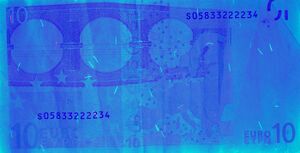Hylemetry
The term Hylemetry, in modern-day parlance, refers to a type of banknote authentication, invented by G. Schirripa Spagnolo in 2008.[1] It was used for the first time in an international context in 2010.[2][3] The hylemetric approach is based, as for biometry, in the identification of a unique random characteristic, used to create a template, which can uniquely identifying the object. Hylemetric identification requires properties which are unique, permanent, measurable, and non-invasive, i.e., that the characteristics can be measured without modifying anything. A typical example is the security metallic fibers distributed inside banknotes.
Background
It is a composition of two Greek words: Hyle and Metros. Aristotle used the term ὕλη (hyle) to mean non-living matter.[4] Since biometric identification has given excellent results, it comes naturally to apply similar criteria to uniquely identify “non-living matter”, such as banknotes.
Process
The hylemetric approach is based, as for biometry, in the identification of a unique random characteristic, used to create a template, which can uniquely identifying the object. In theory, every random and irreproducible characteristic could be used in hylemetric identification. However, a valid feature also needs the following properties:
- uniqueness, which indicates that no two objects should be the same in terms of the characteristic,
- permanence, which means that the characteristic should be invariant with time,
- collectability, which indicates that the characteristic can be measured quantitatively,
- non-invasive, which indicates that the characteristics can be measured without modifying anything.
Banknote authentication
A typical example is the security metallic fibers distributed inside banknotes. These, as can be seen in the image (right), are put inside paper pulp during the making of banknote paper, so their distribution and number is absolutely random. It is possible to create a Hylemetric Template, which uniquely identifies a particular banknote, starting from the analysis of the fibers distribution. This approach is also valid for all non-living matter, after having identified one or more correct characteristics.
See also
References
- ↑ G. Schirripa Spagnolo; S. Cerroni (2008). "Hylemetria versus Biometria: Identificazione univoca dell'opera d'arte". Proceeding Elettroottica 2008.
- ↑ G. Schirripa Spagnolo; L. Cozzella; C. Simonetti (2010). "Banknote Security using biometric-like technique: a hylemetric approach". Meas. Sci. Technol. 21. doi:10.1088/0957-0233/21/5/055501.
- ↑ G. Schirripa Spagnolo; L. Cozzella; C. Simonetti (2010). "Currency verification by a 2D infrared barcode". Meas. Sci. Technol. 21. doi:10.1088/0957-0233/21/10/107002.
- ↑ P. M. Huby (1974). "Review: Matter in Aristotle". The Classical Review 24 (1): 44–46. doi:10.1017/s0009840x00241711.


